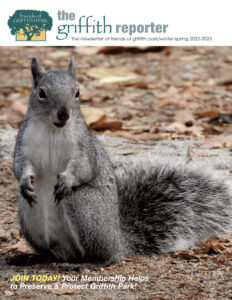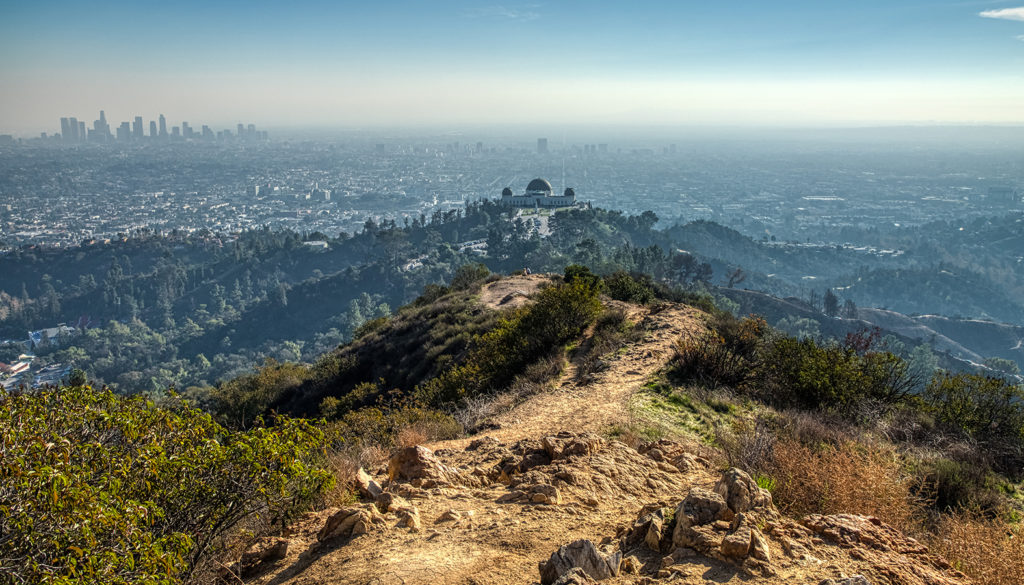At more than 4,210 acres, Griffith Park is one of the largest municipal parks with urban wilderness areas in the United States.
Bordering Los Feliz, Burbank, Glendale, Atwater Village, the Hollywood Hills, the 5 and 134 freeways, and the LA River, it’s almost five times the size of New York’s Central Park and four times the size of Golden Gate Park in San Francisco.
In addition to the wilderness, the park includes the Griffith Observatory, the LA Zoo, the Gene Autry Museum, and Travel Town, with its own museum and a mile-long miniature train ride. A lot of people would like to see even more development.
The all-volunteer Friends of Griffith Park is the main voice advocating to keep the park in its most natural and beautiful state. It’s also the go-to nerve center for the general public.
Recently I sat down with the editor of The Griffith Reporter newsletter, Brenda Rees.
“What’s incredible is that the park is smack in the middle of deeply urban Los Angeles,” Rees said. “Yes, there are golf courses and tennis courts, but you can also look out over the hills in certain places and you don’t know you’re in the city.”
The newsletter reports on important issues surrounding Griffith Park, on the natural world, and on the various people who, whether alone or with a group, enjoy the park. “We want to appeal to everyone,” she said.

With a center spread, thick paper, and lavish photographs, The Griffith Reporter is more like a magazine. Published twice a year, both in print and digitally, it’s mailed out to members, as well as people in the surrounding neighborhoods. Or you can view it online for free.
Rees has persuaded historians, horticulturalists, and geologists to write for the newsletter.
“We have a raptor survey now in its seventh year where we assign people a raptor’s nest to watch,” Rees said. “We have an upcoming piece about night skies.
“We did one column about how if you’re driving down the 134 you see this stretch that’s all barren: no trees, no landscaping. That’s the Toyon Canyon Landfill. Back in the ’50s, the city decided, ‘We have all this trash, let’s just dig a big hole in Griffith Park and put all our garbage in it.’ ”
What I love most about the park is the smell of sage, plus the array of people: elderly ladies power-walking with their visors, tanned buff guys running shirtless, young people talking about their screenplays and restaurant jobs.
“That’s more toward the south, off Los Feliz Boulevard,” Rees adds. “If you go to the Travel Town side, there aren’t as many people. My friends and I always go with a bag to pick up trash. Even if I go by myself, I always feel safe. I do carry a big stick with me, though.”
Many people know of the park because of P-22, a mountain lion that was born in the Santa Monica Mountains, crossed two freeways, and made his home in Griffith Park for 10 years. He was rarely sighted, but people from around the world followed his whereabouts and loved him.
Eventually, his strength and mobility diminished and he began straying from his territory and exhibiting uncharacteristic behavior — like eating a small dog — and last year had to be euthanized.
Members of four local tribes held a private ceremony in which the mountain lion’s remains were buried in the Santa Monica Mountains.
The park abounds with other types of wildlife. One early morning at the top of Rattlesnake Trail, Rees spotted a red-shouldered hawk taking a bath. “And then he went over to the side and coughed up all these bones. It was just a wonderful experience.
“We need that connection with nature. It reminds us that we’re part of this reality, this life of mystery and wonder.”
There are hard stories, too. After Pearl Harbor, a Japanese internment camp was set up within the park. Rodger Young Village, a public housing project consisting of 750 Quonset huts, was built after World War II to address the desperate shortage of homes for returning vets. The site closed in the mid-’50s and is now occupied by the LA Zoo parking lot and environs.
The area is ever-evolving. A section of Griffith Park Boulevard was closed to cars last year, leaving it free for hikers and bikers.
“If you walk there now, there’s a friendliness, an exchange: ‘Good morning!’ ” Rees said. “Your heart opens, even if you’re depressed about the state of the world. You can hear the birds more, too, the towhees in the brush, even the toads.”
Rees is always looking for writers. Personal essays and photos are welcome too. Readers can submit items at [email protected].
Keep your eyes peeled: “We just got a great series of a bobcat eating a squirrel down in Fern Dell,” Rees said.

